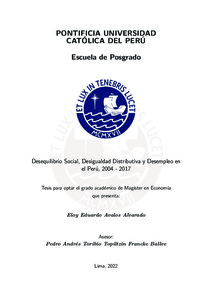| dc.contributor.advisor | Francke Ballve, Pedro Andres Toribio Topiltzin | |
| dc.contributor.author | Avalos Alvarado, Eloy Eduardo | |
| dc.date.accessioned | 2022-11-10T14:52:37Z | |
| dc.date.available | 2022-11-10T14:52:37Z | |
| dc.date.created | 2022 | |
| dc.date.issued | 2022-11-10 | |
| dc.identifier.uri | http://hdl.handle.net/20.500.12404/23758 | |
| dc.description.abstract | El presente trabajo tiene por objetivo principal contrastar una extensión de la hipótesis de la teoría del desequilibrio distributivo formulada por Figueroa (1993, 2015). Para alcanzar el objetivo se construirán dos índices; uno que mide el desorden social y otro que mide la desigualdad distributiva. Luego, utilizaremos la técnica econométrica de datos de panel bajo efectos aleatorios, teniendo como unidades de análisis empírico a los departamentos del Perú para el periodo 2004-2017. Los resultados alcanzados en la presente investigación dan cuenta de que una relación entre el desorden social y la tasa de desempleo; así como entre la desigualdad distributiva y el desequilibrio social, tienen respaldo empírico y están acorde a lo esperado según las formulaciones de la teoría económica basada en la envidia económica y los límites de tolerancia a la desigualdad distributiva. | es_ES |
| dc.description.abstract | The main objective of this paper is to contrast an extension of the hypothesis of
the distributive imbalance theory formulated by Figueroa (1993, 2015). To achieve the objective, two indices will be built; one that measures social disorder and
another that measures distributive inequality. Then, we will use the panel data econometric technique under random effects, having as empirical units of analysis the
departments of Peru for the period 2004-2017. The results achieved in the present
investigation show that a relationship between social disorder and the unemployment rate; as well as between distributive inequality and social imbalance, they
have empirical support and are in accordance with what is expected according to
the formulations of the economic theory based on economic envy and the limits of
tolerance to distributive inequality. | es_ES |
| dc.language.iso | spa | es_ES |
| dc.publisher | Pontificia Universidad Católica del Perú | es_ES |
| dc.rights | info:eu-repo/semantics/closedAccess | es_ES |
| dc.subject | Desigualdad social--Perú | es_ES |
| dc.subject | Desigualdad económica--Perú | es_ES |
| dc.subject | Tasa natural de desempleo--Perú | es_ES |
| dc.title | Desequilibrio Social, Desigualdad Distributiva y Desempleo en el Perú, 2004 - 2017 | es_ES |
| dc.type | info:eu-repo/semantics/masterThesis | es_ES |
| thesis.degree.name | Maestro en Economía | es_ES |
| thesis.degree.level | Maestría | es_ES |
| thesis.degree.grantor | Pontificia Universidad Católica del Perú. Escuela de Posgrado. | es_ES |
| thesis.degree.discipline | Economía | es_ES |
| renati.advisor.dni | 10146581 | |
| renati.advisor.orcid | https://orcid.org/0000-0003-4797-1587 | es_ES |
| renati.author.dni | 07628775 | |
| renati.discipline | 311317 | es_ES |
| renati.juror | Leon Castillo, Janina Virginia | es_ES |
| renati.juror | Francke Ballve, Pedro Andres Toribio Topiltzin | es_ES |
| renati.juror | Cruzado De La Vega, Viviana Natali | es_ES |
| renati.level | https://purl.org/pe-repo/renati/level#maestro | es_ES |
| renati.type | https://purl.org/pe-repo/renati/type#tesis | es_ES |
| dc.publisher.country | PE | es_ES |
| dc.subject.ocde | https://purl.org/pe-repo/ocde/ford#5.02.01 | es_ES |





